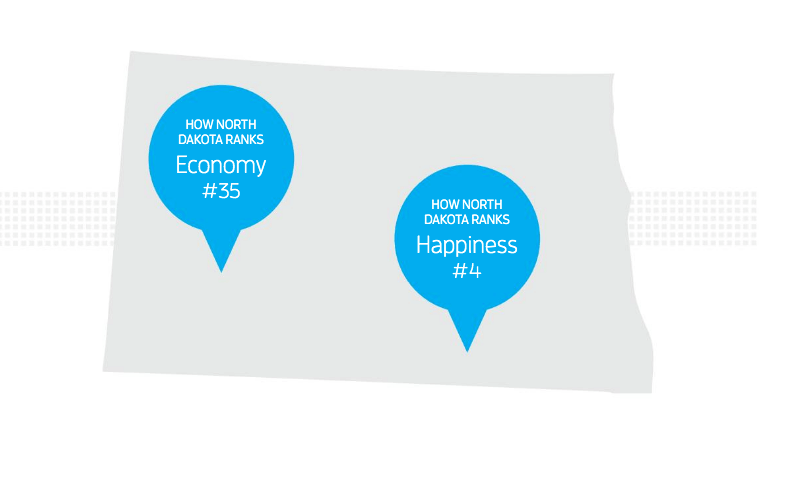By Mari Hall, Kilbourne Group
When it comes to North Dakota, we’re pretty familiar with the middle ground. We’re ranked somewhere in the middle in most categories, such as education (#20), economy (#35) and health care (#38). (We’re the 4th happiest state, though!) We’re even smack at the top of the Midwest, the land of saying hello to strangers and avoiding confrontation. But even the 4th happiest state has room to grow.
In “The Next American City,” Mick Cornett talks about “the Middle” – midsize cities all across the U.S. that make up the economic backbone of our country. These places, says the former mayor of Oklahoma City, are capable of astounding growth, innovation, productivity and pragmatism. Sounds a lot like North Dakota, right?
Cornett provides example after example of these places in the Middle that overcame looming economic challenges or impending cultural crises by tapping into essential parts of their cities’ personalities.
Oklahoma City
In 1987, Oklahoma City lost out to Indianapolis in a contest to lure United Airlines’ new maintenance facility. Desperate city leadership, led by then mayor Ron Norick, had gone to great lengths to secure tax benefits for United Airlines and bring new jobs to a struggling city. Afterward, they took the insight provided by this almost-opportunity to convince citizens to vote “yes” on a one-cent sales tax that would create $200 million in revenue and fund nine projects that completely changed the city’s economy and quality of life.
Seattle
Seattle was growing fast, and city leadership was anxiously working to create a power grid that would meet projected demands. When an ambitious plan to build 20 nuclear power plants fell through, the city turned instead to its history of conservation. Rather than building new power plants to support a growing population’s power needs, they retrofitted older homes to be more energy efficient and undertook a public campaign to encourage energy-conscious habits.
Albuquerque
Then mayor Richard Berry recognized a common problem in his city: homelessness. He saw that organizations aimed at alleviating hunger, poverty and addiction were overwhelmed. So with a van, an initial government investment of $50,000 and a partnership with the community’s non-profits and churches, Albuquerque started the program “There’s a Better Way.” The program was able to connect the city’s homeless with a day’s work on city projects in exchange for a healthy meal simply by meeting them wherever they were. Over the course of eight years, the program connected 200 homeless citizens to full-time employment and reduced the homelessness rate among veterans to a functional zero.
Louisville
As of the 2010 census, Louisville was the 27th largest city in the U.S., but it was perhaps best known for one thing: the Kentucky Derby. However, under the leadership of Mayor Greg Fischer, the ‘Ville’s Office of Civic Innovation has undertaken tech-driven leadership that improves the lives of its citizens year-round in an attempt to stay ahead of the technology curve. This drive for innovation led to advancements such as internet-enhanced children’s inhalers that provide real-time data for kids’ health and provide crucial air quality statistics to city leadership so they can identify pollution hotspots and strive for a healthier city.
Of course, these are just a few of the examples included in “The Next American City” of how cities in the middle have worked to grow an active economy and make sure the people that call these places home are happy and healthy.
It is a marvel to see all the unique ways in which cities got creative to tackle whatever burgeoning problem they faced. But perhaps the most exciting part is that this book holds insight on ways we can make our own state even better (and happier).
In a speech for 1 Million Cups in 2017, entrepreneur and agricultural engineer Barry Batcheller asked the audience to consider what Fargo’s major would be. What’s our core competency when it comes to business and innovation? And by extension, where are our greatest opportunities to shine bright? Since Batcheller issued his challenge, we’ve seen the private and public sectors in North Dakota band together to double down on making the state the world-leader in Unmanned Air Systems and drone technology.
What makes your city unique? What do your residents love about living there? What could your city bet big on to make it an even better place to live? If cities across our state partnered with their private sectors to identify the answers to those questions, it would only serve to make North Dakota a happier place to live.
North Dakota stats
- North Dakota ranks 20th in education.
- North Dakota ranks 38th in health care.
- North Dakota ranks 35th in economy.
- North Dakota ranks 4th in happiness.








